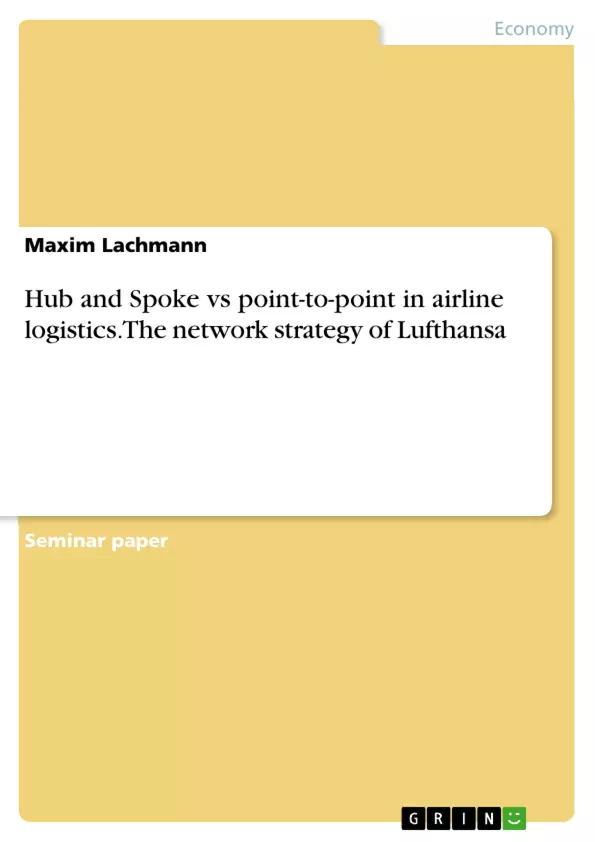The paper provides insight into hub-and-spoke and point-to-point logistics of the airline industry. The author weighs up the advantages and disadvantages of both strategies.
This paper is dedicated to the most applied international logistic network systems, which are: hub-and-spoke and point-to-points. Airlines use these strategic networks in order to reduce different types of costs, optimize their network and flexibility of flight operations. The author elaborates on the different network strategies by putting his focus on one of the biggest German and European airline Lufthansa.
Table of Contents
- Introduction
- Network Logistic Strategies in the Airline Industry
- Hub and Spoke System
- Point-to-Point System
- Strategic Network Systems by Lufthansa
- Lufthansa and Hub-and-Spoke Strategy in Germany
- Cost and Network Analysis
- Advantages and Disadvantages of H&S and PTP Strategies
- Conclusion and Recommendations
Objectives and Key Themes
This paper aims to analyze the application of hub-and-spoke and point-to-point network logistic strategies within the airline industry, focusing on Lufthansa as a case study. It compares the advantages and disadvantages of each strategy to provide insights into network optimization and cost reduction within the airline sector.
- Hub-and-spoke vs. point-to-point network strategies
- Cost analysis of different network systems
- Lufthansa's network strategy and its implications
- Advantages and disadvantages of each network strategy
- Network optimization in the airline industry
Chapter Summaries
Introduction: This chapter introduces the airline industry's growth and its reliance on efficient logistical networks. It highlights the increasing number of passengers and the importance of revenue passenger miles (RPM) as a key performance indicator. The chapter sets the stage for the analysis of hub-and-spoke and point-to-point systems, emphasizing the industry's dynamic nature and global reach. The substantial growth in air travel and the corresponding economic factors are discussed as drivers of the need for efficient logistics. The introduction contextualizes the importance of the subsequent analysis of different network strategies.
Network Logistic Strategies in the Airline Industry: This chapter delves into the two primary network strategies in the airline industry: hub-and-spoke and point-to-point systems. It provides detailed explanations of each system's operational mechanics, including their strengths and weaknesses. The discussion likely contrasts the centralized nature of the hub-and-spoke system, focusing on economies of scale and efficient route management, with the more direct, potentially less cost-effective point-to-point model. The chapter likely explores the trade-offs between cost efficiency and passenger convenience associated with each strategy.
Strategic Network Systems by Lufthansa: This chapter focuses on Lufthansa's utilization of network strategies, primarily examining its application of the hub-and-spoke model. It likely details the strategic location of Lufthansa's hubs, the cost implications of this strategy, and an analysis of the benefits and drawbacks within the German and European context. The chapter probably uses Lufthansa as a case study to illustrate the practical application and challenges of the hub-and-spoke model, demonstrating its complexity and effectiveness in managing a large-scale airline network. Specific examples of Lufthansa's network structure and operational choices are likely provided to showcase the strategic decisions behind their logistical setup. This section most likely includes an analysis of cost implications and potential network inefficiencies.
Frequently Asked Questions: Airline Network Logistic Strategies
What is the main topic of this paper?
This paper analyzes the application of hub-and-spoke and point-to-point network logistic strategies within the airline industry, using Lufthansa as a case study. It compares the advantages and disadvantages of each strategy to provide insights into network optimization and cost reduction.
What are the key themes explored in the paper?
The key themes include a comparison of hub-and-spoke versus point-to-point network strategies, cost analysis of different network systems, Lufthansa's network strategy and its implications, the advantages and disadvantages of each network strategy, and network optimization in the airline industry.
What are the different network logistic strategies discussed?
The paper focuses on two primary network strategies: the hub-and-spoke system and the point-to-point system. The hub-and-spoke system uses central hubs to connect multiple destinations, while the point-to-point system involves direct flights between cities.
How does the paper analyze Lufthansa's network strategy?
The paper examines Lufthansa's utilization of network strategies, primarily its application of the hub-and-spoke model. It analyzes the strategic location of Lufthansa's hubs, the cost implications of this strategy, and the benefits and drawbacks within the German and European context.
What are the advantages and disadvantages of hub-and-spoke and point-to-point systems?
The paper explores the trade-offs between cost efficiency and passenger convenience for each strategy. Hub-and-spoke offers economies of scale and efficient route management, while point-to-point offers more direct routes but may be less cost-effective.
What is the structure of the paper?
The paper includes an introduction, a chapter on network logistic strategies in the airline industry (covering hub-and-spoke and point-to-point systems), a chapter focusing on Lufthansa's strategic network systems, and a conclusion with recommendations.
What key performance indicators are mentioned?
The paper mentions revenue passenger miles (RPM) as a key performance indicator for airline efficiency.
What is the overall goal of the paper?
The paper aims to provide a comprehensive analysis of airline network logistic strategies, offering insights into network optimization and cost reduction within the airline sector.
What is the scope of the paper?
The paper's scope is limited to the analysis of hub-and-spoke and point-to-point network strategies, with a specific case study on Lufthansa. It focuses on the economic and operational aspects of these strategies.
Where can I find more information about airline network logistics?
Further research into airline network logistics could involve exploring academic journals focusing on transportation, logistics, and operations management. Industry reports from airline companies and consulting firms would also be valuable sources.
- Arbeit zitieren
- Maxim Lachmann (Autor:in), 2016, Hub and Spoke vs point-to-point in airline logistics. The network strategy of Lufthansa, München, GRIN Verlag, https://www.grin.com/document/319551



